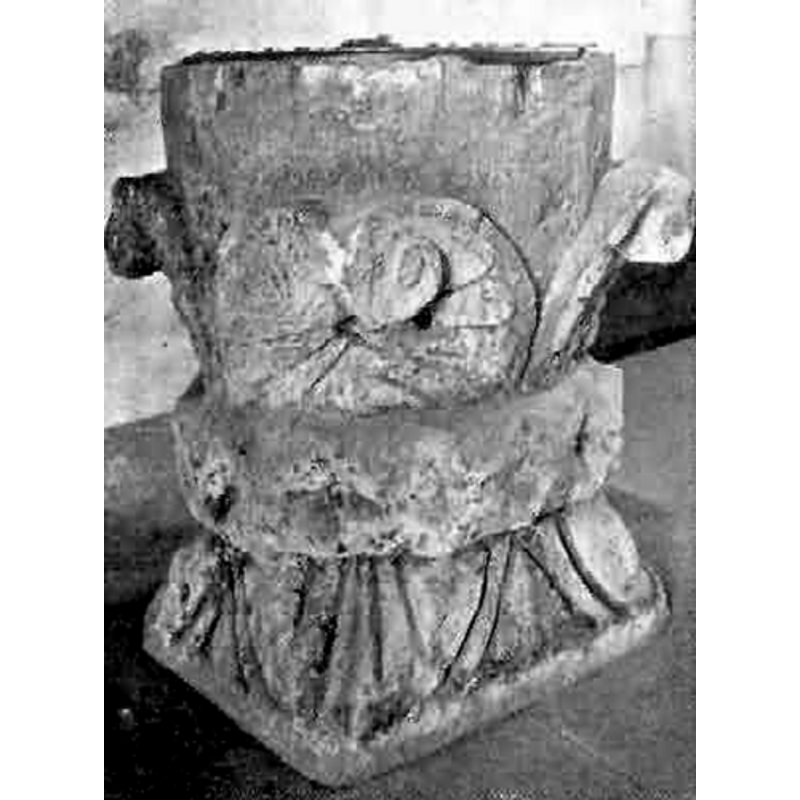Bere Ferrers / Beer Ferrers / Beer Ferris / Beerferris / Bereferrers

Image copyright © Roger Peters, 2005
Permission received (email of 9 January 2005)
Results: 5 records
B01: design element - motifs - foliage
CR01: design element - motifs - diaper or nail-head?
LB01: design element - motifs - foliage
view of font
INFORMATION
FontID: 06604BER
Object Type: Baptismal Font1
Church/Chapel: Parish Church of St. Andrew
Church Patron Saints: St. Andrew
Country Name: England
Location: Devon, South West
Directions to Site: Located 8-9 km NNW of Plymouth
Font Location in Church: Inside the church
Century and Period: 12th century, Norman
Credit and Acknowledgements: We are grateful to Dr. Roger Peters, of www.wissensdrang.com, for his permission to use the transcription of and images from Stabb (1908)]
Font Notes:
Click to view
Described in Lysons (1806-1822): "The font at Beer Ferrers consists of a truncated polygonal shaft, resting upon four foliated ornaments, encircled by a band of rather coarse execution". Listed in Cox & Harvey (1907) as having a baptismal font of the Norman period. Described and illustrated in Stabb (1908): "There is an old font bearing the appearance of having been carved out of the capital of a pillar turned upside down [...], but possibly the idea of the carving may have been taken from a capital." Described and illustrated in Clarke (1914): "A very remarkable font, of limestone; the girdle, which is set very low, is formed of a heavy band of the Norman nail-head. This ornament is the forerunner of the dog-tooth of the succeeding style; I think its use for the girdle is rare; I do not know of any other example. The rest of the font has a certain classical character -- as translated by the local stonemason. Above the girdle is a curious design suggesting a large shell of the percten type, with incised divergent lines to represent flutings: the volute of the shell is expanded , and becomes an Ionic volute. There are four shells, one for each face ; the volute uppermost. Above, the bowl is plain, and shows marks of the axe; they are fine and narrow, thus indicating that the font was made rather late in the Norman period. Below the girdle is a band of plantain leaf ornament, which is carefully designed so as to carry on the lines of moulding which frame the shells. Perhaps the sculptor had an ambitious bent, and having seen classical capitals of columns tried to produce something similar for this font. The volute for the north-east is gone, and the rim is broken in some places. There are four traces of staples or hinges for the cover. The lead lining has received a cout of colour wash. The font stands on a modern octagonal plinth. This font more than any other is perhaps one to which the analogy of the chalice may be applied, for the girdle has so much projection that it may almost be looked on as a knop. But the bowl does not at all resemble the bowl of a chalice, so it cannot be classed as a chalice-font." Noted in The Aniquary (isssue of October 7th, 1871, p. 144). In Pevsner (1952): Font. Circular, Norman, perhaps made up of two capitals. If so they would be evidence of a previous Norman church." Described in Betjeman (1958): "Vigorous Norman font of Hurdwick stone".
MEDIUM AND MEASUREMENTS
Material: stone, limestone (Hurdwick stone)
Font Shape: polygonal (mounted)
Basin Interior Shape: round
Basin Exterior Shape: polygonal
Drainage Notes: lead lining
Rim Thickness: 9.5 cm [calculated]
Diameter (inside rim): 51.25 cm*
Diameter (includes rim): 70 cm*
Basin Depth: 23 cm*
Basin Total Height: 50 cm*
Height of Base: 44.5 cm*
Font Height (less Plinth): 94.5 cm*
Notes on Measurements: *[measurements given in inches in Clarke (1914: 436)]
LID INFORMATION
Date: modern?
Material: wood
Apparatus: no
Notes: flat and plain, with metal ornamentation and ring handle
REFERENCES
Betjeman, John, An American's Guide to English Parish Churches (including the Isle of Man), New York: McDowell, Obolensky, 1958
Clarke, Kate M., "The baptismal fonts of Devon -- Part II", 46, Report and Transactions of the Devonshire Association for the Advancement of Science, Literature and Art, 1914, pp. 428-435; p. 429-430, 436
Cox, John Charles, English Church Furniture, New York: E.P. Dutton & Co., 1907
Lysons, Daniel, Magna Britannia, being a concise topographical account of the several counties of Great Britain, London: Printed for T. Cadell and W. Davies, 1806-1822
Pevsner, Nikolaus, South Devon, Harmondsworth: Penguin Books, 1952
Stabb, John, Some old Devon churches, their roods, pulpits, fonts, etc., London: Simkin, [et al.], 1908-1916
![textured leaves, with four [one missing] large volutes](/static-50478a99ec6f36a15d6234548c59f63da52304e5/compressed/0040427012_compressed.png)